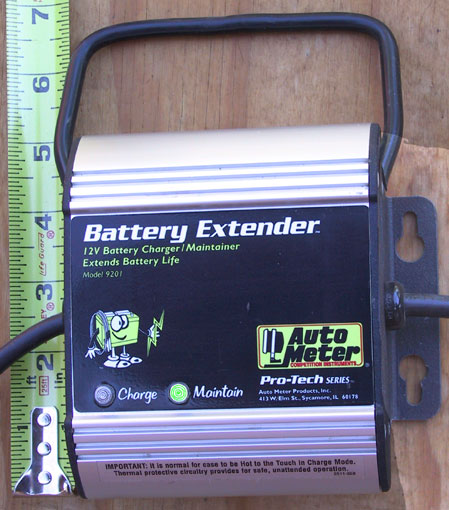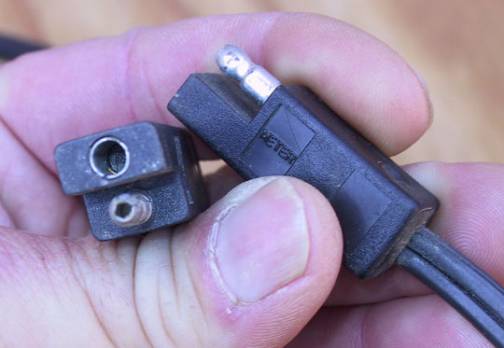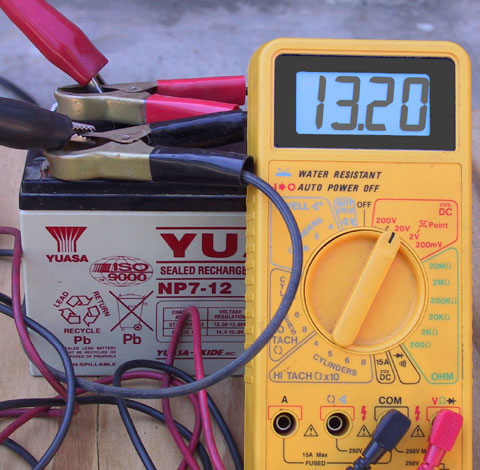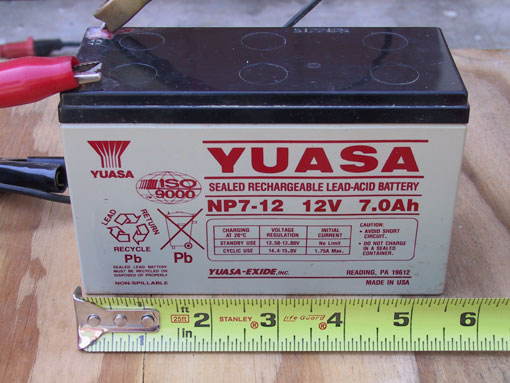|
BATTERY
CHARGING & MAINTENANCE
Small
(Parasitic) drains on the battery will require Battery
Maintenance when our Hot Rods are parked for extended time
periods and…
When
recharging a low battery SLOW RATE is the most thorough
and gentle method.
High Powered alternators
on modern Hot Rods can be abusive to partially discharged
batteries. /
And the partially discharged battery can cause
alternator overheating too.

The
AutoMeter battery extender in these photos has been much
used and also much appreciated during the last three or
four years, at M.A.D. Enterprises.
We had much need for it around here, and purchased
this one from P.A.W. (Performance Automotive Warehouse).
Knowing that AutoMeter products are consistently
first class, we actually saved the box, intending to offer
a product report to friends.
We
have a few vehicles, not all are driven frequently, and as
with any car equipped with modern equipment, small
“parasitic drains” kill the batteries when a
vehicle is parked for extended time periods. Even at a professional facility, concerned exclusively with
automotive electrical systems, we found the battery
situation expensive, inconvenient, and irritating in
general.
SMALL DRAINS WHEN
PARKED
In
the many years of testing and servicing cars, we have
found that cars equipped with modern electronics will have
small drains when parked.
Not that there is any electrical system defect, and
the drains are of such a small amount that they would
never be noticed if the car was driven significant
distance at least a couple of times per week.
Even
a small “entry level” radio with a station memory and
clock will cause a small drain.
Add an alarm system, and more drain will be added.
Add a computer for electronic engine management
(modern fuel injection) and the amount of the drain will
grow larger yet.
BCI
used to publish in their battery service manual that “a
drain of more than 0.1 amps is a problem, and should be
fixed.” Battery
Council International is the
organization that gives us industry standards for battery
sizes and levels of electrical power, as well as practical
guidelines for testing and servicing batteries.
BCI gives us “group sizes,” and electrical
specs such as Cold Cranking Amps to measure starting
power, and Reserve Capacity rating to judge how far we
might drive if the alternator fails.
The recommendations and standards of rating given
to us by the BCI are in general very practical and useful.
However,
in the “real world” the amount of drain that is
“normal” and can be tolerated is a gray area–It’s
not practical to draw a steadfast line for acceptable
amount of small drain on the battery when a car is parked
and shutdown.
An amount that is normal for one car might be
excessive for another.
And the amount of drain that will be a problem
largely depends upon how frequently the car is driven.
In example, a drain measured at between 0.02 and
0.03 amps might be normal and not a problem for a well
equipped, late model, daily driven car.
But the same 0.02 to 0.03 amp drain will soon take
its toll on a battery in a Hot Rod, if the car is only
used for short drives on an occasional basis.
Therefore,
we must use a little judgment and logic where drains on
batteries are concerned.
We could disconnect the battery every time the car
is parked, and reconnect the battery every time we go for
a drive.
And if the battery is hidden, we could even install
a “main battery switch” to make it simple to
disconnect the battery.
But, expect that we will have to reset the radio
stations, and the clock too (if we want the time set), and
we cannot use the on board alarm system.
With modern factory electronic engine management
systems, constantly disconnecting the battery may be worse
yet.
Various systems will behave differently, but expect
that any diagnostic codes will be erased.
And the “history of driving memory” which helps
the engine perform well will also be erased.
(And it can take up to 20 warm-up/cool-down cycles
for the “history” to become embedded in the computer.)
And also,
we
should consider that a battery lasts the longest and
performs the best when stored in a fully charged
condition.
Occasional charging at least a small amount helps
to keep the lead surfaces within the battery clean, which
helps a battery to keep its full level of power rating a
lot longer.
All
factors considered,
a
special maintenance battery charger can be a very good
investment.
Ordinary, small “trickle” chargers can be
dangerous when left unattended, and they can also destroy
a battery by overcharging when they are forgotten.
Ideally, a maintenance type charger will have
special electronics to prevent overcharging when in use
for long time periods.
And the latter is the special and sensitive part of
designing and building the maintenance charger.
The good maintenance charger will also be fully
protected from overloads to prevent fire.
Most small battery chargers have overload
protection, although the automatic-reset circuit breakers
can get dangerously hot after cycling for a while.
A fusible device would be a better choice with the
maintenance charger, because it may be left unattended for
long periods of time.

Our
“Battery Extender” from AutoMeter has been extensively
used, outputs have been measured, and as we expected from
an AutoMeter product, it’s exactly what we like.
Re-Charge rate, taper-off, Voltage and Amperage
outputs at maintenance mode, all seem perfect.
We
have taken a few photos, to show some of the performance
aspects. Finding
a battery charger that will put out a large amount of
current when a battery is discharged is easy.
And so we did not bother with a photo showing the
output in “Charge” mode.
However, we have measured several times, and it is
as advertised; a 1.25 Amp maximum rate battery charger
when in “Charge” mode.
- The
built-in electronics switch from Charge mode to
Maintenance mode when the battery reaches exactly 14.2
volts.
- When
it is in the Maintenance mode, battery voltage has
never exceeded a 13.21 measurement on our test meter.
- And
in Maintenance mode, current output will taper off to
as low as 0.01 amps.
- Also
in Maintenance mode, if small electronic devices on
the Hot Rod use more power than the charger delivers,
it will switch back to Charge mode when battery
voltage drops to exactly 12.60 volts on our meter.
Then at 14.2 volts it will again switch back to
Maintenance mode.
Performance,
all functions, factory preset-by-electronics charging
rates, and reliability, has all seemed perfect with the
AutoMeter Battery Extender.
About
the only test we have not done is to leave the same
charger on the same battery for more than 3 weeks
non-stop. (And
that is only because we have just one of these neat little
chargers, and several cars with batteries to maintain.
So all the cars are wired for the quick-disconnect
on the charger output cord, and periodically the charger
gets moved from car to car.

Here
is the charger in the “Maintenance mode,” notice the
green indicator light is glowing.
We included the tape measure in this photo, to show
the approximate size of the charger.
Also notice that the charger does have a handy
carry-handle, and convenient flush-mount brackets to make
it a permanent garage fixture, where the Hot Rod is
stored.

This
close-up photo shows the connector in the cord from the
charger to the battery.
The insulated, round pin “bullet connector
terminals” are the most reliable connector used for
automotive. The
charger is thoughtfully packaged with two types of cord
ends for the battery.
One of the cable assemblies has the traditional
spring loaded clip-on ends (as typically found on small
battery chargers). And the other cable assembly has ring terminals, which may be
permanently installed on the car.
The round pin bullet connector was a very good
choice for a quick disconnect in a cable from a small
battery charger, as they are very reliable.
TIP
Since the
quick-disconnect (bullet connectors) at the charger output
cord does not have a “retaining latch,” it can also
serve as an automatic disconnect feature.
(1) Mount
the charger securely to the garage wall, and also strain
relief mount part of the output cord to the wall with
insulated clamps. (2)
Install and wire the battery end of the cord
permanently on the car.
Leave the connector where it will be convenient to
plug in, but safe and out of sight when not in use.
And STRAIN RELIEF the charging wires securely to
the car with insulated clamps.
And
then, should the car accidentally be driven away while
still plugged into the charger, the quick disconnect
should merely disconnect with no damage to the car or to
the charger. (I
did not space out! I was distracted!
Honest!) At
least all is well, thanks to AutoMeter for using this type
of connection in the charger cord.

Here
we are measuring the battery charge rate in amps, in
Maintenance mode, as the battery approaches a fully
charged condition.
Eventually the charger will drop to a 0.01 amp
rate, indicated on this meter, when the battery reaches
full charge.
The charge rate is tapered off by electronics in
the charger, to prevent over charging the battery.

And
here we are measuring voltage at the battery, also in
Maintenance mode.
This is a good level for charging a battery during
extended periods of time.

Why
we used this small battery as a model for our example test.
The
small battery is a much smaller “electrical storage
reservoir” than a big car battery.
Therefore, the little battery allowed the charger
to trim off the charge rate in less time than a big car
battery, so that we could better show in photographs the
small charge rate when in Maintenance mode.
Output specs of the AutoMeter we were testing were
well within the battery charging specs, which are printed
on the battery. As
we mentioned previously, it’s easy to find a high rate
battery charger that will over-charge and destroy
batteries when it is forgotten while plugged in.
Finding a safe, effective, easy on the battery type
of charger is not so easy to find.
IN SUMMARY
We
like the AutoMeter unit very much, and we recommend it.
We paid the full purchase price, plus tax, plus
shipping, and got no discount when we bought it from P.A.W.
Yet, it was a very good investment–and we wish that
everything we purchase would work out so well.
No
doubt there are many applications that could use this
charger. Motorcycles
during the off-season winter months, riding lawn mowers,
and boats too. RV’s
that nearly always have small drains, and that nearly
always get parked for long periods of time between
vacation trips. Snowmobiles
during the off-season summer months, and agricultural
machines that are used only on a seasonal basis, are other
examples of machines with automotive type batteries that
may be stored for extended time periods–and that need
battery charging maintenance.
However,
before connecting this model charger to a battery for
months-at-time, non-stop charging, contact AutoMeter.
We have not tested the charger for such extended
periods of time, and we are not sure that this charger
model is intended for such use.
The
Battery Extender charger and other great AutoMeter
products may be seen at www.autometer.com


|